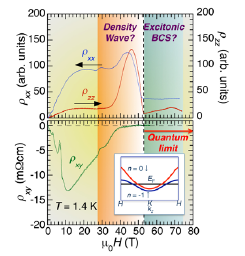Possible Excitonic Phase in the Quantum Limit State of Graphite
Tokunaga and Kindo Groups
The quantum limit state, where all carriers are accommodated in the lowest Landau level, exhibits various anomalous phenomena because of the strong correlation acting on the carriers confined by magnetic fields. This state can be realized only in extremely high magnetic fields, the order of 104 T, in ordinary metals.

Fig. 1. (upper) In-plane (ρxx) and out-of-plane (ρzz) resistivity of graphite single crystals as a function of magnetic field applied along the c-axis at temperature of 1.4 K. (lower) Magnetic field dependence of in-plane Hall resistivity (ρxy) of graphite at 1.4 K. The colored areas represent different electronic phases suggested by transport measurements. The inset of the lower panel shows schematic illustration of the dispersion curves of the populated subbands above 53 T.
Graphite is a semimetal having a small number of electrons and holes ( ~ 3 × 1018 cm-3 for each) and goes into the quasi-quantum limit state, where only the lowest electron-like (Landau index n = 0, spin ↑ and ↓) and hole-like (n = −1, ↑ and ↓) subbands are populated in magnetic fields above 7.4 T applied along the c-axis. With further increasing the field, emergence and collapse of a density wave state has been claimed through measurements of in-plane (ρxx) and out-of-plane (ρzz) resistivity [1]. In addition, recent magnetoresistance measurements up to 80 T suggested emergence and collapse of another gapped state at 53 T and 75 T, respectively [2]. The actual nesting vector in these density wave states and also the underlying structure of the subbands, however, remain unclear as yet because of the limited experimental technique available above 25 T.
We studied Hall resistivity (ρxy) and magnetization in single crystals and pyrolytic graphite in pulsed high magnetic fields [3]. As the main feature of the results, the ρxy becomes almost zero as the field approaches 53 T, where ρxx and ρzz show anomalies as shown in Fig. 1. In the microscopic point of view, the Hall resistance is given by summation of the matrix elements of the current operator between the states having different Landau indices Δn = 1 and, hence, sensitive to the whole dispersion curves of the relevant subbands. The almost zero Hall resistance seems consistent with the existence of two populated subbands (n = 0↓ and n = −1↑) [1] rather than the less-symmetric three subband model (n = 0↑ , n = 0↓ and n = −1↑) [2]. Thereby, the quantum limit state likely emerges above 53 T. In this quantum limit state, density wave can be formed by the nesting between the Fermi points of the n = 0↓ and n = −1↑ subbands, which is equivalent to the BCS-like pairing state of excitons. Further studies are needed to clarify the nature of the additional phase transition at 75 T in this quantum limit state.
References
- [1] H. Yaguchi and J. Singleton, J. Phys.: Condens. Matter 21, 344207 (2009).
- [2] B. Fauqué et al, Phys. Rev. Lett. 110, 266601 (2013).
- [3] K. Akiba et al, J. Phys. Soc. Jpn. 84, 054709 (2015).
